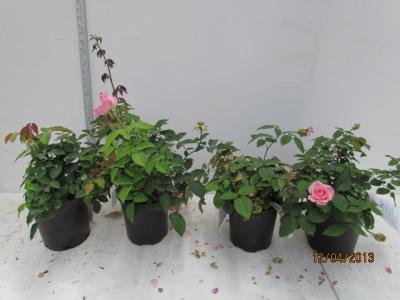Earth-Kind roses analyzed for salt tolerance

'Belinda's Dream' was recommended for high salinity soil. Control plants are show on the left of the photo. The two plants on the right were irrigated with saline nutrient solution at an electrical conductivity of 10.0 dS/m. Credit: Photo courtesy Genhua Niu
Earth-Kind® roses are favorites with gardeners and landscapers. Chosen for their superior tolerance to heat, drought, and pests, as well as their outstanding performance in landscapes, Earth-Kind® roses can thrive in most environments, even with limited care. A new study focused on determining the best Earth-Kind® varieties for withstanding the challenges of salt stress.
As alternative water sources such as reclaimed water are becoming more commonly used as irrigation for urban landscapes and agricultural crops, plants are being subjected to higher levels of soluble salts, which can ultimately cause salt stress in plants.
In arid and semiarid regions, high soil salinity is the result of low rainfall and high evapotranspiration, while in northern regions it is caused by deicing salts. Increasing soil salinity negatively affects plant growth and development, so screening and identifying salt-tolerant plant species and cultivars is becoming increasingly important.
Looking to inform rose enthusiasts and growers, researchers at Texas A&M University evaluated 18 popular varieties of Earth-Kind® roses for salt tolerance. Their findings were published in HortScience (May 2014.) The rose cultivars were tested in greenhouses in College Station and El Paso, Texas, in response to two salinity levels at electrical conductivity: 1.2 and 10.0 dS·m-1.
“The salt tolerance of Earth-Kind® rose cultivars was consistent in the two locations with strong positive correlations of relative shoot dry weight, flower number, and visual quality score in the 10 same cultivars between two locations,” said corresponding author Genhua Niu. 'Belinda's Dream', 'Climbing Pinkie', 'Mrs. Dudley Cross', 'Reve d'Or', and 'Sea Foam' were the most salt-tolerant cultivars. 'Cecile Brunner', 'Else Poulsen', 'Madame Antoine Mari', 'Perle d'Or', 'Spice', and 'Souvenir de St. Anne's' were the least salt-tolerant among the 18 cultivars analyzed in the study.
“Identifying and using salt-tolerant garden roses is important in landscapes where soil salinity is high or irrigation water quality is poor,” said the authors. They recommended 'Belinda's Dream', 'Climbing Pinkie', 'Mrs. Dudley Cross', 'Reve d'Or', and 'Sea Foam' as good selections for planting in landscapes with high soil salinity. 'Cecile Brunner' and 'Else Poulsen' were not recommended, as they had the lowest relative shoot dry weight and flower number of the cultivars tested.
The complete study and abstract are available on the ASHS HortScience electronic journal web site: http://hortsci.ashspublications.org/content/49/5/544.abstract
Founded in 1903, the American Society for Horticultural Science (ASHS) is the largest organization dedicated to advancing all facets of horticultural research, education, and application. More information at ashs.org
Media Contact
All latest news from the category: Life Sciences and Chemistry
Articles and reports from the Life Sciences and chemistry area deal with applied and basic research into modern biology, chemistry and human medicine.
Valuable information can be found on a range of life sciences fields including bacteriology, biochemistry, bionics, bioinformatics, biophysics, biotechnology, genetics, geobotany, human biology, marine biology, microbiology, molecular biology, cellular biology, zoology, bioinorganic chemistry, microchemistry and environmental chemistry.
Newest articles

Sea slugs inspire highly stretchable biomedical sensor
USC Viterbi School of Engineering researcher Hangbo Zhao presents findings on highly stretchable and customizable microneedles for application in fields including neuroscience, tissue engineering, and wearable bioelectronics. The revolution in…

Twisting and binding matter waves with photons in a cavity
Precisely measuring the energy states of individual atoms has been a historical challenge for physicists due to atomic recoil. When an atom interacts with a photon, the atom “recoils” in…

Nanotubes, nanoparticles, and antibodies detect tiny amounts of fentanyl
New sensor is six orders of magnitude more sensitive than the next best thing. A research team at Pitt led by Alexander Star, a chemistry professor in the Kenneth P. Dietrich…





















